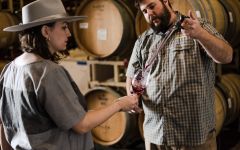Pellegrini Zinfandel 2019



Product Details
Your Rating
Somm Note
Winemaker Notes
A fine balance of delicacy and structure, the Pellegrini 2019 Alexander Valley Zinfandel spills over with boysenberry, marionberry, nutmeg, and brambles on the nose. Firm tannins and light hints of clove provide a backdrop for black cherry, raspberry, pomegranate.
Other Vintages
2018-
James
Suckling
-
Wine
Enthusiast





The Pellegrini Family traces its heritage in winemaking to the early 1900s when brothers Nello and Gino Pellegrini arrived in New York City from their native Tuscany. They soon made their way to the West Coast and in 1925 became Sonoma County grape merchants, shipping grapes throughout the U.S. for home winemaking. In 1933 after repeal of Prohibition, the brothers established the original Pellegrini Wine Company, shipping grapes from Sonoma County and producing quality wines for many of San Francisco's finest shops and restaurants.
In 2003, the eight children of Robert, Richard and Jeanne–the "eight cousins"–purchased a 12-acre parcel of old-clone Zinfandel alongside the Olivet Lane Estate, launching the fourth generation of the Pellegrini family into the wine business.
Together, the family continues to produce some of Sonoma County's finest wines, and is committed to continuing the legacy of distinction and quality, now and for future generations

Unapologetically bold, spice-driven and jammy, Zinfandel has secured its title as the darling of California vintners by adapting well to the state's diverse microclimates and landscapes. Born in Croatia, it later made its way to southern Italy where it was named Primitivo. Fortunately, the imperial nursery of Vienna catalogued specimens of the vine, and it later made its way to New England in 1829. Parading the true American spirit, Zinfandel found a new home in California during the Gold Rush of 1849. Somm Secret—California's ancient vines of Zinfandel are those that survived the neglect of Prohibition; today these vines produce the most concentrated, ethereal and complex examples.

Nearly a northern extension of Napa Valley, Alexander Valley starts just north of the small, Knights Valley, and is just a few minutes drive from the Napa town of Calistoga. It is Sonoma County’s hottest AVA. But the Russian River, which runs through the valley, creates cooler pockets and its soft, alluvial soil is ideal for grape growing, especially Cabernet Sauvignon. In fact, some believe that Alexander Valley Cabernets truly rival the best from Napa Valley and many of the heavy-hitter producers have largely invested here.
In addition to Cabernet Sauvignon, which makes up over 50% of plantings, Merlot and old vine Zinfandel thrive here. Ample, fleshy Chardonnay and Sauvignon Blanc dominate white wine production. Some old-vine plantings of Grenache have also been discovered and more recent experiments with Sangiovese and Barbera show great promise.
